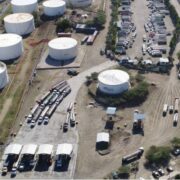Met Service messages: What do they mean? Loop Jamaica
Black Immigrant Daily News
For half the calendar year, June to November, the Americas face the threat of tropical storms, hurricanes and other natural hazards during the Atlantic Hurricane Season.
In recent years, the seasons have been very active, and there is another predicted active season for 2022 with 14 to 21 named storms. Six to 10 of these storms are expected to develop into hurricanes, and three to six will be major hurricanes of category three and higher.
With this information, Jamaicans must know the meanings behind the messages issued by the Meteorological Service of Jamaica during this time.
The Meteorological Service of Jamaica, a division of the Ministry of Economic Growth and Job Creation, is responsible for observing weather conditions over the island and its surrounding waters. It also issues advisories and warnings concerning the observed weather developments and gives instructions on what actions are to be taken.
Information from the Met Service to the public includes evacuation messages, watches, warnings, and bulletins. These advisories communicate different levels of threat from natural hazards. Among the most known advisories are those of watches and warnings that are issued for flash floods, tropical storms and hurricanes.
Addressing the Office of Disaster Preparedness and Emergency Management’s (ODPEM) disaster preparedness town hall in Clarendon recently, Director of the Meteorological Service of Jamaica, Evan Thompson, shared what each type of advisory means.
Director of the Meteorological Service of Jamaica, Evan Thompson (Photo: JIS)
Flash Flood Watch and Warning
“When we talk about a flash flood warning it doesn’t just mean that flooding is possible, but the flooding has already started to occur, whether in your area or somewhere very close. That means that it is going to impact you shortly. So, when we issue a flash flood watch or a flash flood warning it means that those flooding conditions are going to affect a particular area, and we are going to tell you what area,” said Thompson.
He added that it is important for individuals to know their environment and know which advisories apply to their locations and which do not. For this reason, weather advisories state the areas that may experience hazardous weather condition(s).
Storm Watches and Warnings
“Then there are the ‘storm watches’ and the ‘storm warnings’ and they are a little bit different because when we talk about ‘tropical storm watch’ what we mean is that conditions that are associated with a tropical storm are possible in your area within two days. Of course, if we say, ‘hurricane watch’, it means, therefore, that hurricane conditions are what is likely to occur in your area, still within two days. When we change those watches to warnings, it means that not only is the condition a possibility, but it is expected in your area, and you don’t have as much as two days anymore. You have maybe one and a half days or maybe less,” continued Thompson.
He reminded the public that during the period, tropical storms and hurricanes are not the only threats to the country. We may also experience tropical waves and tropical depressions that move across the island. Then there are thunderstorms and tornados that may develop out of hurricane conditions.
Bulletins, Advisories and Notices
Nevertheless, prior to a predicted weather system affecting the island, the Meteorological Service of Jamaica first disseminates a bulletin to alert the country that there is a threat. As that threat develops or becomes more certain, the next step is to the issuance of an evacuation advisory. This, the Director of the Meteorological Service explained, is not an evacuation notice for land but the seas and often involves the assistance of the Jamaica Defence Force coast guard.
“If we believe that we have to issue a watch – a tropical storm watch or a hurricane watch – we will say ‘listen, if you are out at sea, if you are a fisherman that works out at sea, or if you know fishermen that work at sea, you need to pass on the message that you need to leave the seas and come back to the land and you must get to the land before we issue the watch’. The coast guard is activated to go out and make sure that we can find people out there and let them know what is happening, get them into the land, evacuating the seas and the cays and banks,” he said.
Once these advisories are issued, it is recommended that individuals prepare for the pending weather conditions by securing lives, livelihoods and property.
During impact by a tropical storm or hurricane, the Meteorological Service of Jamaica provides updates as the system affects the country.
Thompson also encourages that during the Atlantic Hurricane Season, individuals know where to get their information and what information to trust.
“You must know the messages, but you must also know where to get your information. Call the Met Office if you need to. They are always on duty 24 hours a day to answer your calls if you need information. If all you want to know is what is the latest warning message that was issued, all you have to do is dial 116,” Thompson said.
He also advised that Jamaicans should have the telephone numbers of the Meteorological Service and the ODPEM saved for easy access to information and that individuals visit www.metservice.gov.jm to see weather advisories and warnings.
“Knowledge is power. When you know, you know what to do. So, we have to make sure that all we need to know is in our heads, and we get ready to take the action we need to take,” said Thompson.
— JIS
NewsAmericasNow.com










Leave a Reply
Want to join the discussion?Feel free to contribute!